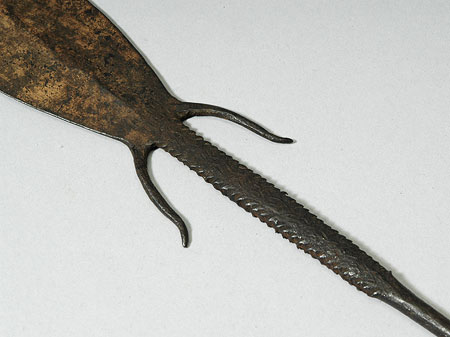Accession Number:
1994.27.1
Country:
Sudan
Region:
[Southern Sudan]
Cultural Group:
?Dinka ?Mandari
Date Made:
?1950s
Materials:
Iron Metal
Process:
Forged (Metal) , Hammered , Decorated , Incised
Dimensions:
Total L = 426; blade L = 252, W = 49, th = 4.8; upper tang W = 11.8, th = 4.5; lower tang diam = 6.5 mm [RTS 28/6/2005].
Weight:
212.9 g
Other Owners:
Part of the collection of Ronald Godfrey Lienhardt - collected either by himself or by Jean Carlile Buxton, and donated to the museum by his executor, John H.W. Penney.
Field Collector:
?Ronald Godfrey Lienhardt or Jean Carlile Buxton
PRM Source:
John H.W. Penney
Acquired:
Donated June 1994
Collected Date:
1940's - 1950's
Description:
Iron spearhead with a narrow, leaf-shaped blade, thickened to form a raised ridge down the centre of both sides, creating a lozenge-shaped section to the blade.
Two narrow, curving barbs extend down from the base of the blade, roughly round in section and tapering to their tips.
The spearhead has a solid tang, the upper part of which has a rectangular section, and has been chiselled along the edges to create a roughened, barbed finish.
The tang then begins to taper and becomes round in section, ending in a roughly finished point.
The lower part of the blade has been decorated on both sides with 2 horizontal rows of short incised vertical lines, while the flat upper and lower faces of the upper tang are covered with 2 rows of a broken zigzag pattern.
The object is nearly complete, but has suffered some use damage to the tip and edges of the blade, with a small piece of metal now missing from one side.
The surface has rusted, giving the metal a brownish colour (Pantone black 4C).
It has a weight of 212.9 grams and a total length of 426 mm; the blade is 252 mm long, 49 mm wide and 4.8 mm thick at its centre; the upper part of the tang is 11.8 mm wide and 4.5 mm thick, while the lower part has a diameter of 6.5 mm.
This spear came from the collection of Dr Godfrey Lienhardt, and may have been collected by Lienhardt during his fieldwork among the Dinka in the 1940s and '50s, or by Jean Carlile Buxton during her fieldwork among the Mandari in the same period and bequeathed to Lienhardt. It was donated to the museum in 1994.
Langton comments on the accession book entry for 1979.20.76 that the spears used by the Dinka Tuich were obtained in trade, with the better-made more traditional examples produced by the 'Jur Lao', and usually inferior 'copies' made by Arab smiths at Omdurman. The Dinka word for spear is Tong, usually modified by a second word that describes its appearance.
Rachael Sparks 30/9/2005.
This spear came from the collection of Dr Godfrey Lienhardt, and may have been collected by Lienhardt during his fieldwork among the Dinka in the 1940s and '50s, or by Jean Carlile Buxton during her fieldwork among the Mandari in the same period and bequeathed to Lienhardt. It was donated to the museum in 1994.
Langton comments on the accession book entry for 1979.20.76 that the spears used by the Dinka Tuich were obtained in trade, with the better-made more traditional examples produced by the 'Jur Lao', and usually inferior 'copies' made by Arab smiths at Omdurman. The Dinka word for spear is Tong, usually modified by a second word that describes its appearance.
Rachael Sparks 30/9/2005.
Primary Documentation:
Day book entry
- [dated 16/6/1994, marked as donation, object given by Dr John Penney] ...
Oxford.
"Dinka spear head from the collection of Dr Godfrey Lienhardt".
Letter dated 3rd October 1994, from Jeremy Coote to J.H.W.
Penney, thanking him for the donation of the Dinka/Mandari spear, and sending him a copy of the computer printout for it; with the further comment that the spear has been sent to conservation [both in RDF file].
Pitt Rivers Museum label - AFRICA, SUDAN. ?DINKA, ?MANDARI. SPEAR-HEAD. Don Dr John Penney. 1994.27.1 [plastic label with metal eyelet; red circular sticker on back indicates object has been photographed; tied to object; RTS 24/6/2005].
Pitt Rivers Museum label - AFRICA, SUDAN. ?DINKA, ?MANDARI. SPEAR-HEAD. Don Dr John Penney. 1994.27.1 [plastic label with metal eyelet; red circular sticker on back indicates object has been photographed; tied to object; RTS 24/6/2005].




